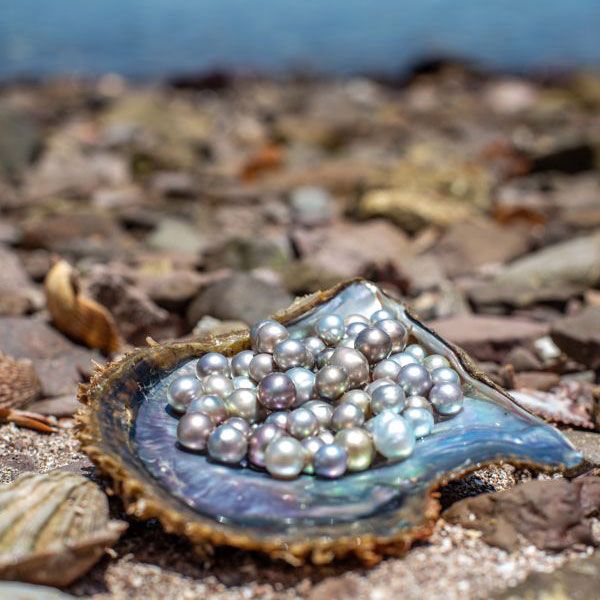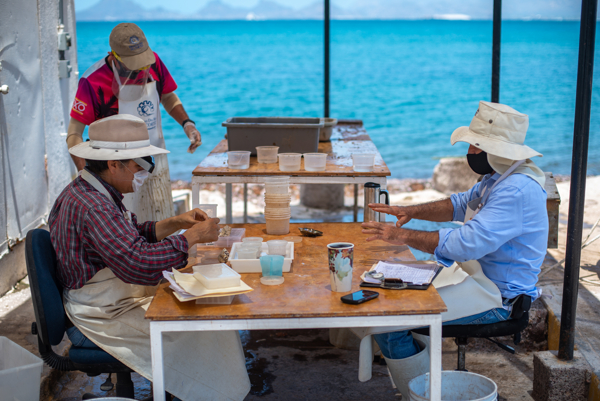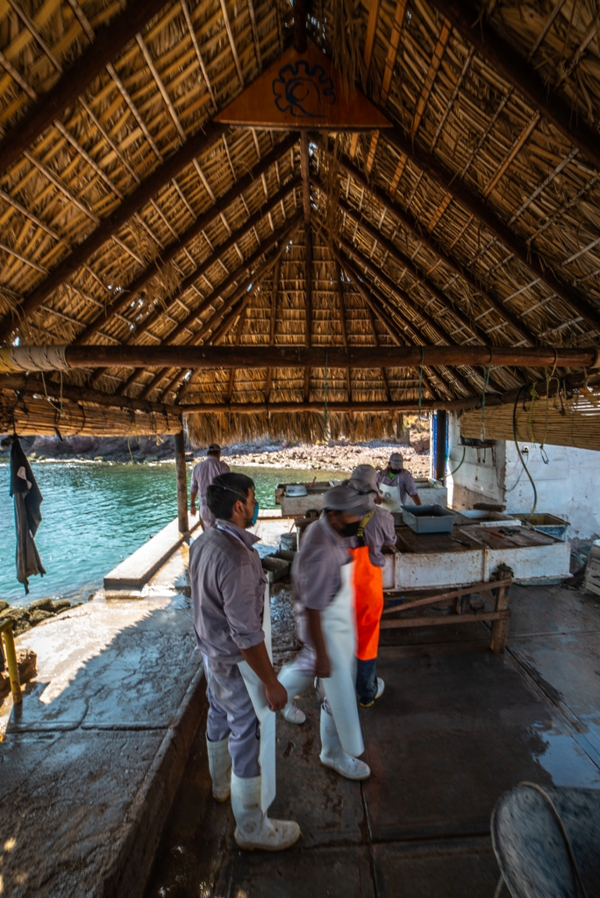Above and Beyond Sustainability - Pearl Farms Take the Lead

Ann A. Flick covers two case studies of the sustainability in perliculture of Cortez Pearl farming and its effects on the environment, population and its economy.
Legend says that one can see the future in the luster of a pearl. What future does it hold for the industry?
With increasing frequency, jewelry professionals around the globe are encountering supply chain terms like, “sustainable” and “sustainability,” being applied to business practices within the industry. But have they yet given thought to what practices might lie beyond? Regenerative, renewable, a circular economy? While most probably have not, some industry members have already initiated them.
As the majority of the jewelry community struggles to first understand a clear definition of sustainable, its impact and how it specifically relates to its day-to-day operations and global resources, watching the movie, Avatar, might provide valuable insight. The plot of this science fiction thriller packs a powerful message; the inhabitants of the fictional Pandora (meaning all gifts), whose extraordinary world survives by maintaining and restoring the delicate balance between environment, natural resources and life, are in conflict with the alien miners who are destroying and depleting their planet. “Our great mother does not take sides…she protects the balance of life; all energy is borrowed and one day you have to give it back.” (Cameron, 2009).
In 2018, the Jewelry Glossary Project (JGP) was formed in response to the growing use and misuse of key terms related to sustainability and responsible practices. The project team defines sustainable as “practices that protect environmental integrity and promote human health in the sourcing, production, sale and distribution of jewelry” (Jewelry Glossary Project, 2018).
In an interview with Ann Flick, Rick D. Blasgen, former President and CEO of the Council of Supply Chain Management Professionals (CSCMP), sustainability, “is a business issue affecting an organization’s supply chain or logistics network in terms of environment, risk and waste costs, while positively impacting return on investment and competitive advantage.” Blasgen goes on to emphasize that corporate social responsibility (CSR), another key in contemporary business practices, encourages companies to create operations that enhance society and the environment rather than contribute negatively.
Blasgen’s definitions are undoubtedly a reference to general business models that impact all segments of the global supply chain from conception to consumption. However, the global supply chain is pervasive—as was coined by the late Dr. Thomas W. Speh (Council of Supply Chain Management Professionals, 2006). And since the jewelry community relies on the broad scope of the industry and its logistics operations to exist and profit, understanding their broader applications is unquestionably essential.
Considering that, as Speh maintained, the supply chain is pervasive, then its functions and practices not only affect the viability of the business community at large, but also impact the daily lives and well-being of the global population. They also impact our environment. A ramification that pearls farmers know all too well.
And while our current pandemic may seem unrelated to sustainable practices, many infectious disease experts list climate change and other adverse environmental issues as major contributors to a rise in the creation of viral pathogens, such as COVID-19. (Harvard T.H. Chan School of Public Health, 2020).
This crisis along with smaller scale epidemics, continued pollution and the increasing magnitude of natural disasters tell a tale; our own “great mother” is not happy. But the recent clearing skies and other positive environmental shifts indicate that a change in business practices and population habits have the potential to reverse the disruption in nature’s balance. Therefore, if greater strides are made to give back, restore and regenerate, it is not too late to make these changes permanent and create more.
The Ellen MacArthur Foundation, advocates for an innovative approach to current business practices which takes them beyond sustainable—a circular economy which is based on the principles of designing out waste and pollution, keeping products and materials in use, and regenerating natural systems. Only by transforming the entire traditional take-make-waste system, can a thriving economy be created with the potential to benefit “everyone within the limits of our planet.” (Ellen MacArthur Foundation, 2017).
Taking a closer look at some of the sustainable practices launched by marine perlicuture—whose farms rely on a balanced, clean marine ecosystem—can provide jewelers with a better understanding of the role that sustainability and “beyond” can play in their own viability. And how that in turn can contribute to the well-being of our world, both its inhabitants and its environment.
Long before the JGP addressed and defined the terms for its glossary, Dr. Laurent E. Cartier, a project manager for the Swiss Gemmological Institute (SSEF) who holds a PhD in Earth Sciences from the University of Basel (Switzerland), was already focusing his research on sustainability and traceability issues in pearl farming.
To Cartier, pearl farming presents a fascinating case in which science was the catalyst that transformed an industry plagued by overexploitation into becoming a model for sustainable resource management. He adds that adopting and implementing the appropriate practices will not only create sustainability throughout the industry, but also positively impact the local populations and communities as well as the economic stability of the farms.
To further his research and promote responsible pearl farming, Cartier—working with the University of Vermont (United States) and other partners—became the co-founder of the Sustainable Pearl Project in 2011. This research initiative collaborates with pearl farmers and other partners in Switzerland, Japan, the United States and the Pacific region, while it examines how the cultured pearl supply chain and its consumers could provide more support to an industry that can potentially offer positive environmental and socio-economic benefits to the Pacific region.
The project team created five Sustainability Principles with an updated version published in 2014. They are as follows: 1) Protection of the Biosphere; 2) Sustainable Use of Natural Resources; 3) Production Transparency and Product Disclosure; 4) Develop and Operate Farms in a Socially and Culturally Responsible Manner and; 5) Management Commitment and Local Law Compliance (Sustainability Principles for Marine Cultured Pearls Version 2, 2014).
In his article, “Pearl Farming as a Sustainable Development Path,” co-authored with Dr. Saleem H. Ali in 2012, Cartier discusses the threats to marine waters and ecosystems due to climate change, overfishing and unregulated coastal development and their negative impact on marine resources, as well as the humans who rely on them for food and well-being. He feels that sustainability in the pearl farming industry has the potential to benefit both in that it provides great opportunities by combining the preservation and conservation of marine biodiversity with viable economic activities for local populations.

Despite challenges, pearl farming can be profitable and offers employment and economic opportunities to areas where few exist. There are also additional uses for the oysters beyond pearl production. Shells are used in button manufacturing, ground for medicinal purposes and dietary supplements and contained in beauty products. Even the adductor muscle, often called “pearl meat,” is sold for human consumption. All of these provide additional revenue and minimize waste. Therefore, deterioration and sudden ecological changes not only affect the harvesting and quality of the pearls produced, but also the economics of the farm and that of its local population. Undeniably, Cartier concludes, that “financial and ecological sustainability are intimately and inextricably linked.” (Cartier & Ali, 2012).
To-date, Cartier and the project team have conducted numerous case studies—two of which are the Kamoka Pearl Farm in French Polynesia and Perlas del Mar de Cortez® in Mexico.
During a presentation on sustainability in marine cultured pearl context at the 2020 Pearl Forum Inhorgenta Munich Show in February, Cartier stated, “’Sustainability is a word that has been thrown around a lot…The next few years will move from making claims to being able to measure up to what you are saying.’” (Bates, 2020).
For Kamoka Pearl, a generational pearl farm located in the lagoon of the nutrient rich Ahe Atoll, 300 miles from Tahiti, is proving it by taking the next step beyond sustainability.
From its establishment in 1991 by the Humbert family, Kamoka Pearl has been a pioneer in eco-farming techniques. The Kamoka team, who live and work together in a communal setting, are dedicated to being “good custodians” of the Ahe lagoon, its surrounding waters and land as well as its marine inhabitants. Some of the practices they have implemented to achieve this include solar and wind powered electricity, rainwater catchment systems for freshwater, and fully biodegradable septic systems. By creating a clean ecosystem with pristine waters and making efforts to protect the lagoon’s marine life, the team has provided a reserve which allows fish populations to safely reproduce and contribute greatly to the conservation of coral reefs. Even the mother of pearl nuclei used to implant the oysters is a renewable resource from those they cultivate. All of the above contributes to not only helping the ecosystem and environment, but also to improving the quality of beautiful and coveted Tahitian pearls grown on the farm.
Another major contributing factor to the farm’s sustainable efforts is their team and its shared sense of enterprise. By paying fair wages and working as a family, employee turnover is low which results in retained expertise with a strong commitment to the farm’s sustainable objectives. They also make sure that the farm operates in accordance with local law compliance, and works with the local communities and artisans whenever possible to source Kamoka’s non-pearl materials. Giving back is also achieved by donating funds to national programs and disaster relief efforts
Josh Humbert began working on the project alongside Patrick Humbert, his father and the farms founder, shortly after its conception. After becoming friends with an experienced Japanese grafting technician, he focused on learning the trade, which resulted in a life-long desire to produce beautiful pearls. In 2002, he bought the business from his father who still manages the day-to-day operations. Embracing his father’s vision—Humbert strives not only to sustain the fragile ecosystem, but also to regenerate it.
Humbert’s advocacy for nature and its beauty can be seen in his amazing photography—not only for his farm and product, but also for National Geographic® Magazine, to which he has contributed since 2012. He is also a National Geographic Expedition tour leader.

According to Humbert, what takes Kamoka beyond a sustainable operation to a truly regenerative farm is its methods and operations, all of which have been directly responsible for boosting fish and oysters’ populations in the Ahe Lagoon. “Our oysters ‘foul up’ with a myriad of different organisms that make the mollusks and the baskets their home,” Josh explained. When the oysters are brought to shallow water platforms, they are cleaned by the fish instead of using high powered hoses which can cause havoc to the ecosystem. Since each fish species targets different food sources, the result is a strengthening of many different species of the lagoon’s fish. The water depth at which the oysters are kept and their proximity to one another also results in more successful reproduction. And due to the greatly increased success rate in reproduction, their population—once almost extinct from over-fishing—is slowly returning.
Humbert believes that pearl farmers are at ground zero for the health of the world’s oceans. For their farms to survive and thrive, farmers depend on a well-balanced ecosystem—whether it’s ocean acidification, ocean temperature, sea level rise or the phenomenon of microplastics in the waters. “I think of us [pearl farmers] as the proverbial canaries in the coal mine of the ocean,” says Humbert, using the metaphor to emphasize that he and his fellow farmers are the first to be aware and then to warn of an ecosystem imbalance that can cause damage to businesses and the global environment alike. Taking immediate steps to put it back in balance is crucial—to the farms, to the local communities and to the global environment.
In 2014, Kamoka’s long history of dedication to eco pearl farming led Humbert to join other industry leaders including Mikimoto, Tiffany & Co and Paspaley as a key note speaker at the first Sustainable Pearl Forum held in Hong Kong. Kamoka’s commitment to sustainable practices and beyond remains one of the strongest in the industry.
On the other side of the globe, the same year as Kamoka Pearl’s initial launch in 1991, three Biochemical Engineering graduate students from the I.T.E.S.M. (Monterrey Technical Institute, Mexico), Enrique Arizmendi Castillo, José Manuel Nava Romo and Douglas McLaurin Moreno, were finally realizing their dream of bringing pearls of historical legend back to life in the Sea of Cortez, Baja California—where oyster fishing for pearls dated back 400 years until its ban in 1939 due to overfishing.
As their pearl farming continued, the students witnessed a significant and positive occurrence—not only had pearl oyster beds reappeared along the neighboring Sonoran coasts, but the oysters were also exactly the same species of those being cultured, Pteria sterna. Eventually, oyster fishing permits were again granted, six decades after their ban in 1939.
The project and its spin-off pearl farm underwent several evolutions before becoming the farm now known as Perlas del Mar de Cortez® or Cortez Pearls®, its English version. Although the journey of the three students to reintroduce the legendary pearls was not fraught with the 17th century perils of pirates and other dangers that faced the very first pearl fishery, they describe it as one taken with “tenacity, serenity and good spirits.”
From its beginnings, the farm implemented methods and practices specifically adapted to protect and regenerate the species native to local waters. In his presentation on sustainability in pearl farming at the 2019 Chicago Responsible Jewelry Conference, Enrique Arizmendi, co-founder and head of research and development for Cortez Pearls®, stressed that the farm considers itself to be a defender of the ecosystem—a role which is necessary to create and maintain a healthy ecosystem for oysters not only to survive and thrive, but also to produce high quality pearls.
Cortez Pearls® continues to be committed to its original objectives: 1) environment protection; 2) social responsibility and 3) product integrity. To adequately protect the environment, factors posing negative and harmful impact to the sea must be observed and quickly addressed. These include: garbage; chemical substances; eutrophication from algae, fishing of various marine species that seek refuge in the bay’s cove introduction of non-native oyster species, and saturation of the ecosystem’s carrying capacity. Achieving the farm’s objectives also requires identifying and strengthening positives influences, some which include: recovery of local populations of native species, establishing and guarding a refuge area for depleted marine populations such as clams, octopus, etc.), and providing a nursery for the recently hatched fingerlings every summer, thus taking on the role of an artificial reef.
It soon became evident that simply doing the “right thing” was not sufficient. As a result, the pearl farm presented a proposition to the Mexican legislative body—along with the fishery officials, academics and others interested in establishing pearl farms—to create proper guidelines for perliculture in Mexico. After seven years of open forums and discussions, in 2013, the Mexican government published official legislation, Norma Oficial Mexicana (N.O.M.), in order to regulate the cultivation of four indigenous species of pearl oysters in waters under the federal jurisdiction of Mexico; one of which is Pteria sterna—the oyster grown by Cortez Pearl®. For the pearl farm this was an incredible step forward. Not only was the system working, but it had also created a legacy for the protection of pearl oyster populations with the most timely and advanced concepts available—and those which considered every separate oyster population a unique and evolving unit.
Some of the N.O.M. regulations include: 1) no introduction of foreign species; 2) no mixing of oyster populations; 3) no triploids or tetraploids (which produce a genetic abnormality); and 4) breeding only through family lines. Complying with the government’s regulation along with sustainable practices has unquestionably had a positive and beneficial impact on the local ecosystem.
The farm has succeeded in re-establishing and substantially increasing its population, and has preserved the natural beauty of the Sea of Cortez while protecting other marine life native to the bay and sea waters. And the owners have authored several articles about their successful operation, including one on effectively using a UV lamp to identify pearls from the Pteria sterna (Arizmendi, et al, 2016).
Worker and community relations have also been an integral part of the of the farm’s operation since its launch. They consider fair labor an essential practice that promotes employment satisfaction and creates good company-employee relationships, which in turn benefit the entire team. And in a small business-like Cortez Pearl®, each team member has multiple rolls. “You can see me selling at gem shows, diving, grafting the oysters, working with inventory, grading the pearls and much more,” Arizmendi stated.

Arizmendi also points out that social responsibility includes fostering a good relationship with the local community. The farm’s operation has helped to restore and maintain the natural beauty of the sea and surrounding land-scape as well as to maintain public areas. It also supports the local economy by providing employment opportunities and promoting tourism. This “giving back” results in the community taking pride in the farm and its reintroduction of a long lost and beautiful regional product.
Each June, often referred to as “the month of pearl,” Cortez Pearls® holds an event to launch its annual harvest. The Giving Back Ceremony is a ritualistic part of the launch during which the workers return those pearls that did not meet the farm’s rigorous quality standards. The tradition not only symbolizes giving back what the sea has given, but also returns the biogenetic gems to the sea’s floors, allowing the organic material to eventually be broken down and regenerated in the waters. As Arizmendi so adequately states, when the link between man and nature is broken, there are always consequences. “You must have all the pieces together to create a balance.”
Inarguably, the case for implementing sustainable practices in the jewelry industry is compelling and continues to be in the forefront of these initiatives. Cartier’s research clearly illustrates the beneficial impact of the pearl farms’ sustainability practices on ecosystems, local populations, financial stability, the global environment and our planet. As Cartier stressed, they are “intimately and inextricably linked.”
As for taking the next steps, Cartier believes that beyond sustainable depends on how sustainability is defined. “I see the ‘beyond’ as having an element of regeneration, of positive impact, of giving back. And investing in our future, rather than maintaining the status quo.”
On July 9, 2020, Cartier joined three other industry notables on a webinar hosted by CIJBO, The World Jewellery Confederation, Positioning the Pearl as a Sustainable Gem. The panelists, from Jewelmer and Paspaley representing pearl farms, from Pearl Paradise representing retail and Cartier representing the scientific community, all shared a strong commitment to sustainable practices and a perspective that pearl farming was in a partnership with nature—as both Arizmendi and Humbert have also stressed.
At the end of the session, Jeremy Shepherd, CEO of Pearl Paradise and author and instructor of the Cultured Pearl Association of America’s (CPPA) pearl specialist certification course, Pearls As One, summed up the future of the industry and its importance very simply, “Pearls give back.” Indeed they do—and so should we.
A pearl’s luster may reflect an image of what is and perhaps what may come to pass, but the real future of the industry—and our planet—is up to you.
Author’s Note: While this article only covers two case studies of sustainability in perliculture, it should be noted that there are many other industry pioneers as well as newer farmers who have launched or are currently exploring sustainable and regenerative practices in their operations. We applaud their efforts.
Ann A. Flick has been a freelance writer and editor for CSCMP and the supply chain industry. She received her CPPA Pearl Specialist Certification in 2020.
REFERENCE
Arizmendi, Enrique, Karampelas, Dr. Stefanos & Nava, Jose Manuel. 2016. “Perlas del Mar de Cortez: Cultured Pearls from Mexico,” InColor, Summer 2016, pp. 26-32. Retrieved Oct 9, 2020 (http://www.gemstone.org/incolor/Incolor32/index.html#26).
Bates, Rob. 2020. “The Next Step for Responsibly Sourced Jewelry: Prove It.” Retrieved Sept 18, 2020 (https://www.jckonline.com/editorial-article/responsibly-sourced-jewelry/).
Cameron, James. 2009. Avatar. Film. 20th Century Fox.
Council of Supply Chain Management Professionals. 2006. CSCMP toolbox. Lombard, Illinois. Council of Supply Chain Management Professionals. (https://www.worldcat.org/title/cscmp-toolbox/oclc/130758565).
Cartier, L.E., Ali, S.H., 2012. Pearl Farming as a Sustainable Development Path. The Solutions Journal, Vol. 4, Issue 3. Retrieved Oct 9, 2020 (http://www.thesolutionsjournal.com/node/1139).
Ellen MacArthur Foundation. 2017. “What is the Circular Economy.” Retrieved Oct 9, 2020 (https://www.ellenmacarthurfoundation.org/circular-economy/what-is-the-circular-economy).
Harvard T.H. Chan School of Public Health., 2020. “Coronavirus, Climate Change, and the Environment A Conversation on COVID-19 with Dr. Aaron Bernstein, Director of Harvard Chan C-CHANGE.” Retrieved June 21, 2021 (https://www.hsph.harvard.edu/c-change/subtopics/coronavirus-and-climate-change/).
Jewelry Glossary Project. 2018. “sustainability.” Retrieved Sept. 18, 2020 (https://jewelryglossaryproject.com/sustainable-sustainability/)
Sustainability Principles for Marine Cultured Pearls Version 2. 2014. “5 Sustainability Principles for marine cultured pearls.” Retrieved Oct 9, 2020 (http://www.sustainablepearls.org/sustainability-principles/sustainability-principles/).
